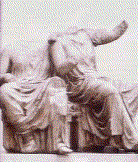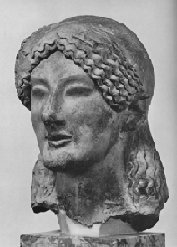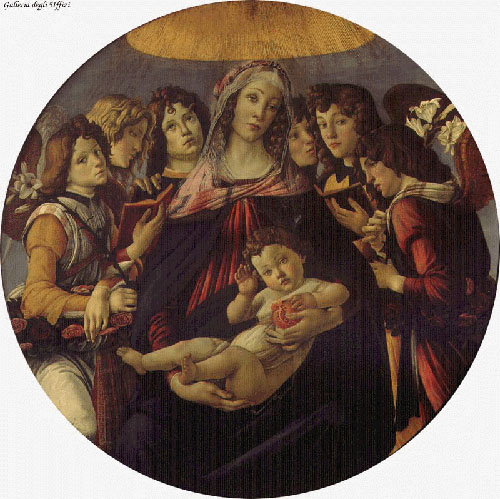

I've been fascinated by the myth of Persephone for a long time. The more I study her myth, the more interesting I find it. The original Persephone was a significant figure in Greco-Roman myth. She was the daughter of Demeter. The early Greeks called her "Kore."
Demeter, whose name means literally either "The Mother" or "Barley Mother," was the Goddess of grain and harvest, and hence of agriculture. Her Roman name was Ceres, from which we get the word "cereal." She was one of the oldest, if not the oldest, Goddess and was, as you can imagine, widely worshipped.
Zeus, also known as Jupiter, was the father God and king of the Gods, and reputed to be Persephone's father as well.

The story most often told about Persephone, is that when she was a young girl, she was out one afternoon playing and wandered away out of sight of her mother. Hades, the God of the Underworld, came and kidnapped her. Demeter was distraught at the loss of her daughter, and travelled the world searching everywhere for her, weeping bitter tears. Because of her sadness, winter came, and continued so long that all the people began to starve.
The people prayed to Zeus and begged him for mercy. Zeus heard their cried and forced Hades to give Demeter back her little daughter. And Hades did, but not before Persephone ate some seeds from a pomegranate. Some say that Hades tricked Persephone into eating the fruit. Some say she reached out and plucked it as her mother was leading her out of hell. Because Persephone had eaten the seeds, she was bound to return to the Underworld. But because she ate only a little and not the entire fruit, her imprisonment was not eternal - for three seasons a year, she could return to her mother and live above ground.

And that, according to the legend, is why the seasons change. Every year, as autumn turns to winter, Persephone must go back to the Underworld. The warm earth cools under Demeter's burden of sorrow. The people slow as they feel her heavy grief. The animals still and settle as the land is watered by her tears. Every year, as winter drags to an end, Persephone can return to her mother and spring bursts forth from the joy of their reunion. This legend shows Persephone as the personification of spring. I have heard her name translated as meaning "She Who Shines In The Dark," and that seems eminently suitable to this version of the story.
When I originally read the myth, I liked the way it celebrates the strength of the mother-daughter, parent-child bond, especially as I was brought up in a Christian tradition which places so much emphasis on the father-son relationship.
Demeter's profound love for her daughter has such intensity, it holds the power to literally change the face of the earth, overcome the machinations of evil, and help Persephone escape the depths of hell.
Persephone's fate inspired Irish poet Eavan Boland to write the lovely poem, The Pomegranate, which reflects on this relational aspect of the Persephone myth.
However, as stories are told again and again over the course of time, they pass through many minds and memories, and can change their shapes like a living thing. The details may blur, the focus may shift, and even a name can have more than one meaning.
In some older versions of Persephone's story, she was a young woman, not a young girl, and instead of accidentally wandering away, she had gone deliberately adventuring, when she fell, or was lured, or was kidnapped into Hell. Here Persephone's adventurous spirit leads her into difficulty, instead of her being a passive victim of the wickedness of others. Her relationship with her mother gives her the courage to explore her world, and when events take a bad turn, their relationship gives her the strength to survive.
In a still older version, Persephone heard the despairing cries of the dead and chose freely to go into the Underworld to comfort them. Hades does not appear at all, in this version. Here Persephone's descent to hell illustrates inclusiveness for every being, whether in the Underworld or in our present one, and shows that mercy is integral to her nature.
In the most ancient layer of myth, Persephone's name means "She Who Destroys The Light." She was the powerful Goddess of the Underworld long before anyone knew of Hades. Like the Indian Kali, the Irish Morrigan, and the Sumerian Ereshkegal, she was the Goddess of Death.
This sounds alarming to modern ears, but many of the religions that existed before Christianity emphasised the importance of the balance between life and death, and to them, the Goddess of Death was as important as the Goddess of Life. In this way, Persephone was not only the daughter of the Goddess Demeter who created and sustained life, but also her partner in maintaining existence.
Her story in all its forms has clear parallels with the sacred cycles of birth, death and rebirth; and can be read as a metaphor for the cycle of seed grain, or any other vegetation. Not surprisingly, both Persephone and her mother were venerated as Goddesses of grain.
Although a lot of time has passed since the legend of Persephone was first told, some echoes of her myth remain. Pomegranates are still a symbol of the realm of the dead, even in Christian iconography.

Some sources believe that a pomegranate, and not an apple, was the original fruit from the Tree of Knowledge of Good and Evil in Genesis. In this painting by Botticelli, Mary and her baby son Jesus are shown with a pomegranate, to remind the viewer that in Christian belief, when Jesus grows up and dies on the cross, he will by his sacrifice overcome death.
For those who worship the Goddess, however, by her many names and in her many forms, in essence, the dual Goddesses Persephone and Demeter represent the two sides of the coin of life and death, and the necessity of each to the other.
And that's why I love the Persephone myth, which, like all myths, is true, but only basically. Because it has drama and passion and that deep love at its center, true; because it reverences the cycles I live in and by, also true; because reading and re-reading it gave me my first experience of how a simple narrative can have as many layers of truth in it as a archaeological site has had histories, yes; but mainly because the essence of the myth shows me that no matter where I may be, no matter how deep or high I travel, how many miles far from home, I am in the presence of the sacred.
© Tehomet 2003
Visit some other pages to do with Persephone:
Moonshadow's homepage in the Rockies - feminist links and resources from a "RebelliousProChoiceMilitantRadical... Thinking-For-HerselfDyke!" on the www.persephone.org domain.
Persephone's Page - a personal page with another telling of the story of Persephone here.
Dark Goddesses -- find out more about Persephone and other Goddesses of the twilight here at this very atmospheric site.